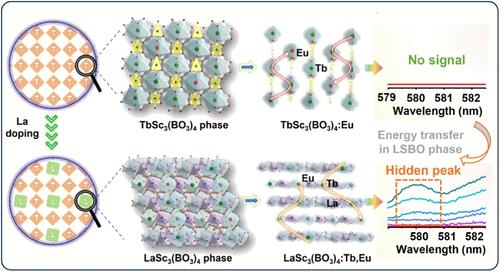Enlarged Site Determination Signals of Eu3+ for Tracking Structural Phase Transition in Terbium-Rich TbSc3(BO3)4 Borate
IF 7
2区 材料科学
Q2 CHEMISTRY, PHYSICAL
引用次数: 0
Abstract
Phase transitions exert profound effects on luminescent behavior, while conversely, luminescence can serve as an effective probe for monitoring phase transitions. Trivalent europium ions (Eu3+) are well-known lattice probes since their nondegenerate 5D0–7F0 transition directly reflects the number of nonequivalent crystallographic sites in host materials. However, the emission intensity of the 5D0–7F0 transition in general compounds is typically too weak for reliable detection under ambient conditions. Herein, La3+ and Eu3+ codoped terbium-rich TbSc3(BO3)4 phosphor was prepared and studied for the first time. Through efficient energy transfer from Tb3+ to Eu3+, the newly generated peak of Eu3+ occupying the LaSc3(BO3)4 phase can be distinctly observed in lattice site resolution spectra, evidencing the phase transition induced by the small amount of La3+. Considering that a small amount of Eu3+ in the LaSc3(BO3)4 phase can hardly give detectable emission intensity of the 5D0–7F0 transition, the enlarged site resolution ability can be ascribed to an efficient Tb3+→Eu3+ energy transfer inside the LaSc3(BO3)4 phase. In other words, the phase tolerance of TbSc3(BO3)4 by LaSc3(BO3)4 prompts the enlarged site resolution ability of Eu3+ in this terbium-rich inorganic compound. This discovery may propose a complementary spectroscopic approach for tracking structural transformations.

富铽TbSc3(BO3)4硼酸盐结构相变追踪中Eu3+的放大定位信号
相变对发光行为有着深远的影响,而反过来,发光可以作为监测相变的有效探针。三价铕离子(Eu3+)是众所周知的晶格探针,因为它们的非简并5D0-7F0跃迁直接反映了宿主材料中非等效晶体位的数量。然而,一般化合物的5D0-7F0跃迁的发射强度通常太弱,无法在环境条件下进行可靠的检测。本文首次制备并研究了La3+和Eu3+共掺富铽TbSc3(BO3)4荧光粉。通过从Tb3+到Eu3+的有效能量转移,在点阵位分辨光谱中可以清楚地观察到Eu3+新生成的峰占据了LaSc3(BO3)4相,证明了少量La3+引起的相变。考虑到LaSc3(BO3)4相中少量的Eu3+很难产生可探测的5D0-7F0跃迁的发射强度,这可以归因于LaSc3(BO3)4相中有效的Tb3+→Eu3+能量转移。换句话说,LaSc3(BO3)4对TbSc3(BO3)4的相耐受性使得Eu3+在这种富铽无机化合物中的位置分辨能力增强。这一发现可能为跟踪结构转变提出一种互补的光谱方法。
本文章由计算机程序翻译,如有差异,请以英文原文为准。
求助全文
约1分钟内获得全文
求助全文
来源期刊

Chemistry of Materials
工程技术-材料科学:综合
CiteScore
14.10
自引率
5.80%
发文量
929
审稿时长
1.5 months
期刊介绍:
The journal Chemistry of Materials focuses on publishing original research at the intersection of materials science and chemistry. The studies published in the journal involve chemistry as a prominent component and explore topics such as the design, synthesis, characterization, processing, understanding, and application of functional or potentially functional materials. The journal covers various areas of interest, including inorganic and organic solid-state chemistry, nanomaterials, biomaterials, thin films and polymers, and composite/hybrid materials. The journal particularly seeks papers that highlight the creation or development of innovative materials with novel optical, electrical, magnetic, catalytic, or mechanical properties. It is essential that manuscripts on these topics have a primary focus on the chemistry of materials and represent a significant advancement compared to prior research. Before external reviews are sought, submitted manuscripts undergo a review process by a minimum of two editors to ensure their appropriateness for the journal and the presence of sufficient evidence of a significant advance that will be of broad interest to the materials chemistry community.
 求助内容:
求助内容: 应助结果提醒方式:
应助结果提醒方式:


